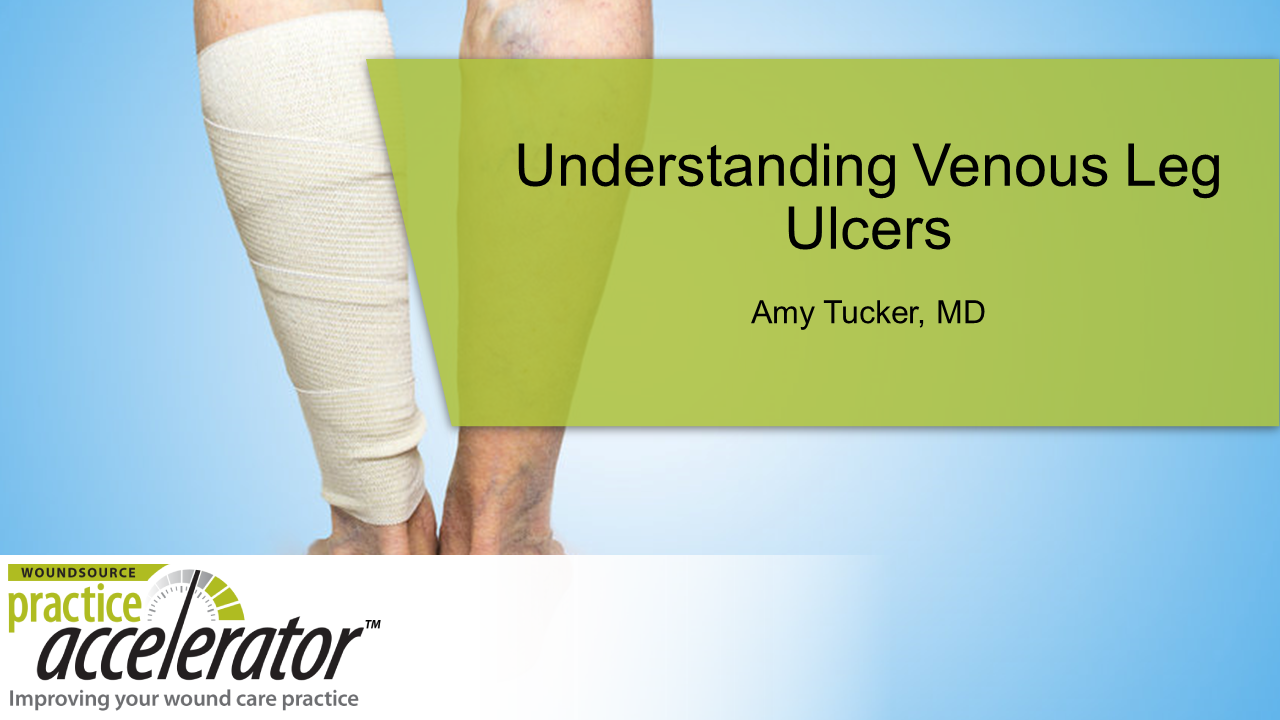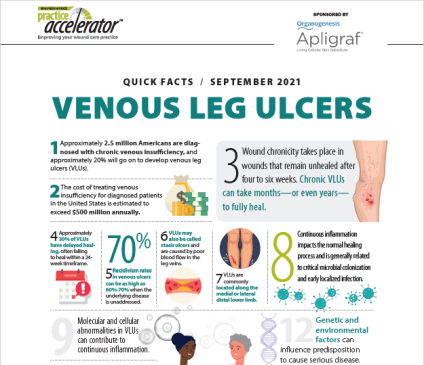
Venous Leg Ulcers
SEPTEMBER IS VENOUS LEG ULCERS MONTH For this month's WoundSource Practice Accelerator series, we are providing education on a variety of topics related to the management of venous leg ulcers. Scroll below to read this month's white paper and articles, to print out our quick fact sheet, and to sign up for this month's webinar.
Upcoming Webinar
Understanding Venous Leg Ulcers
Tuesday, September 28Amy Tucker, MD
Venous leg ulcers (VLUs) account for 70-80% of lower extremity wounds, making them one of the most common etiologies clinicians encounter. Because of their frequency, it is important that health care professionals understand evidence-based treatment methods and the importance of early interventions in these complex wounds. Understanding the etiology of venous leg ulcers is the first step in resolving them. VLUs are caused by venous insufficiency, which causes the blood to pool in the legs. Without putting interventions in place to address this underlying issue, VLUs will not resolve and will continue to occur. Compression therapy is the standard of care for managing and preventing VLUs. In addition to compression, other complicating factors such as infection and biofilm also need to be addressed in order to promote wound healing. The use of advanced therapies that help control bioburden and optimization of the wound environment can support the closure of these wounds. Participants in this webinar will:
- Understand VLU causative factors
- Become familiar with advanced therapies that can promote healing in VLUs
- Understand the importance of early, advanced interventions in wound management

White Paper
Venous Leg Ulcers: The Importance of Comorbidity Management
Venous leg ulcers (VLUs) are common lower extremity wounds that are challenging to treat and that negatively affect patients' quality of life. Numerous factors and comorbidities contribute to the development of venous insufficiency, which can lead to the formation of VLUs....Fact Sheet
Quick Facts - Venous Leg Ulcers 2021
Approximately 2.5 million Americans have chronic venous insufficiency, and approximately 20% will develop venous leg ulcers (VLUs). Treating venous disease and VLUs often requires comprehensive and lifelong wound management. Early detection, proper diagnosis, appropriate treatment strategies, and ongoing management are essential in promoting wound healing in VLUs. Successful VLU treatment engages patients as partners in the care plan, to enhance adherence. This fact sheet for wound care professi...Featured Articles
Factors That Delay Wound Healing in Venous Leg Ulcers
Approximately 2.5 million Americans are diagnosed with chronic venous insufficiency, and approximately 20% will go on to develop venous leg ulcerations. Chronic venous leg ulcers (VLUs) account for 90% of all chronic ulcers of the lower limb region. Wound chronicity takes place in wounds that are st...
Read MoreVenous Leg Ulcer Management: Setting Up for Success
Venous leg ulcers can be slow to heal; the longer a wound is present, the less likely it is to heal. To move a venous leg ulcer through the phases of wound healing may require more than just basic wound care. Chronic venous leg ulcers can be prone to chronic inflammation. Changes in the microcir...
Read MoreUnderstanding Venous Leg Ulcers and Infection
Of all the types of chronic wounds in lower extremities, venous leg ulcers are the most common, and they account for up to 70% of lower leg ulcers. Infection is a common complication in these wounds, however, and may contribute to chronicity. Biofilm is another common complicating factor. Preventing...
Read MoreVenous Leg Ulcers: Selecting a Treatment
Hard-to-heal venous leg ulcers (VLUs) comprise the most common type of leg ulcer and impose a major economic burden on the health care system. These wounds can be difficult to heal, and they often experience recurrence within three months of closure, thus further complicating treatment. When managin...
Read More










